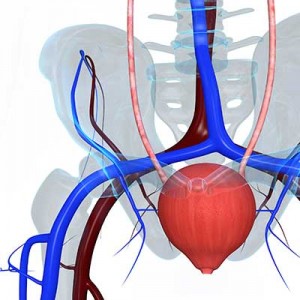What is Overactive Bladder (OAB)?
 Overactive bladder is defined as urgency, with or without urge urinary incontinence, usually with frequency and nocturia. Urgency, the key symptom of overactive bladder, is defined as a sudden compelling desire to go to the bathroom, which is difficult to ignore.
Overactive bladder is defined as urgency, with or without urge urinary incontinence, usually with frequency and nocturia. Urgency, the key symptom of overactive bladder, is defined as a sudden compelling desire to go to the bathroom, which is difficult to ignore.
OAB symptoms occur due to the failure of the bladder to store urine normally and may include:
- Urgency
- Urge urinary incontinence
- Frequency
- Nocturia
Overactive Bladder Management Protocol
When beginning OAB treatment, your urologist will ask you to keep a voiding diary and work closely with you on behavioral modifications to see if this is an effective way to treat your OAB.
If Step 1 is not effective for managing your OAB, your urologist will prescribe a medication plan and monitor your progress.
If appropriate improvement is not made with Steps 1 and 2, your urologist will recommend a series of diagnostic tests known as urodynamics to evaluate the function of the bladder and urethra. These tests provide important information in order for your physician to accurately diagnose and treat your bladder problems appropriately.
If you reach Step 4, this means that Steps 1 through 3 have not proved effective in managing your OAB and your condition falls into a new category called Refractory OAB. Once you are diagnosed with Refractory OAB, there are two procedures often prescribed – InterStim and Botox.
Take Charge of Your Diet & Soothe Your Bladder!
If you are newly diagnosed and your bladder symptoms are raging, you may be in so much discomfort that you simply can’t tell if foods irritate your bladder. Diet modification is a critical first step in gaining control over your symptoms.
It’s time to take charge of your diet to protect and soothe your bladder. For the next three to six months, you should eliminate the most common bladder irritating foods and you’ll also need to do quite a bit of experimentation as you create your own, personalized food list.
Refractory OAB Management
InterStim
InterStim is an option for managing the symptoms of overactive bladder for people who tried other treatments such as medications and behavioral therapy, and those treatments have not worked or were not well tolerated.
Botox
Did you know that Botox is proven to significantly reduce the number of leakage episodes experienced by patients just like you? Botox is a prescription medicine injected directly into the bladder muscle, the purpose of which is to relax the bladder and treat overactive bladder symptoms.
